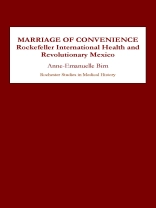Offers a nuanced analysis of the interaction between the Rockefeller Foundation’s International Health Division and Mexico’s Departamento de Salubridad Pública as they jointly promoted public health through campaigns against yellow fever and hookworm disease, organized cooperative rural health units, and educated public health professionals in North American universities and Mexican training stations.
In January 1921, after a decade of bloody warfare, Mexico’s new government found an unlikely partner in its struggle to fulfill the Revolution’s promises to the populace. An ambitious philanthropy, born of the wealth of America’smost notorious capitalist, made its way into Mexico by offering money and expertise to counter a looming public health crisis. Why did the Rockefeller Foundation and Revolutionary Mexico get together, and how did their relationship last for 30-plus years amidst binational tensions, domestic turmoil, and institutional soul-searching?
Transcending standard hagiographic accounts as well as simplistic arguments of cultural imperialism,
Marriage of Convenience offers a nuanced analysis of the interaction between the foundation’s International Health Division and the Departamento de Salubridad Pública as they jointly promoted public health through campaigns against yellow fever and hookworm disease, organized cooperative rural health units, and educated public health professionals in North American universities and Mexican training stations. Drawing from a wealth of archival sources in both Mexico andthe United States, Birn uncovers the complex give-and-take of this early experience of international health cooperation. Birn’s historical insights have continuing relevance for the rapidly evolving world of global health today.
Anne-Emanuelle Birn is Canada Research Chair in International Health at the University of Toronto.
Jadual kandungan
Introduction: The Fever of International Health
A Match Made in Heaven?
Hooked on Hookworm
Going Local
You Say You Want an Institution
Ingredients of a Relationship
Epilogue: International Health’s Convenient Marriage












